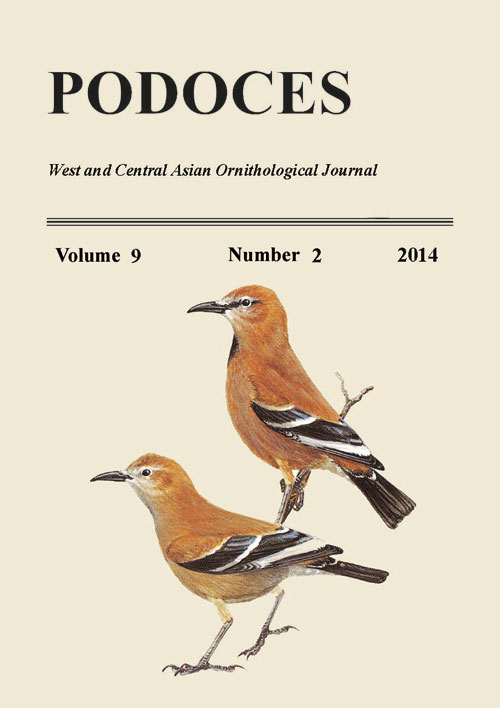فهرست مطالب

Podoces
Volume:9 Issue: 2, 2014
- تاریخ انتشار: 1393/06/28
- تعداد عناوین: 3
-
Page 31Ghaleh-Now wetland, although small in size, is one of the most significant wetlands to the south of the Alborz Mountains, in the vicinity of the capital city of Tehran. A thorough study of the avifauna was carried out at this site during 65 field visits in two periods in the 1970s and 2010s, respectively. The results have revealed that Ghaleh-Now supports no fewer than 196 species of birds, of which 95 percent are migratory birds. This high ratio of migratory species underlines the importance of this wetland as a stop-over site for migrating birds. The difference between the number of species recorded (species richness) in each of the two study periods was not statistically significant (t-Test). However, because of fluctuations in water level, the number of wader species in autumn was lower in the 2010s than in the 1970s. We highlight the importance of such wetlands as vital staging areas for migratory birds and make some suggestions for conservation measures.Keywords: Biodiversity, Ghaleh, Now, Tehran, Waterbirds, Wetland
-
Page 47This study was conducted to estimate species density and diversity of some common resident bird species in relation to increasing human disturbance along the bank of Dal Lake during summer 2013. Data were collected by direct counts made on three fixed width transects (1 km long and 0.1 km wide) which were marked on the road running along the bank of the lake. These three transects represent a gradient of disturbance due to human habitation whereby the first and farthest transect involved low degree and the third transect involved a high level of disturbance. In total, 1,161 birds belonging to 20 species were recorded. Mean bird density differed significantly between transects (ANOVA; F = 3.494, P = 0.037) with the highest being 67.7±26.80 birds/km2 on the first transect and the least density on the third transect (4.5±1.77 birds/km2). The maximum number of bird species (19) was recorded in the low level disturbance transect followed by the medium level of disturbance transect (15) and least in the high level disturbance transect (5). The species studied showed their wariness by avoiding unwanted human social interactions when it lives very near human habitations despite being residents. The low density and low diversity of these birds in the high human disturbance transect point to an almost unbearable tolerance of these species to humans which might ultimately force them to avoid human habitations leading to a more impoverished environment.Keywords: Birds, Common birds, Dal Lake, Density, Diversity, Human disturbance
-
Page 54Every year, many thousands of migratory waterfowls are hunted and consumed by people in the southern Caspian Sea region. Therefore, this study was conducted to estimate the intake and health risks of exposure to cadmium (Cd), chromium (Cr), iron (Fe), lead (Pb), and zinc (Zn) from consumption of Gadwall Anas strepera and Common Teal Anas crecca, two common waterfowl species being hunted in the region. Observed concentrations (μg g-1 wet w) of Cd and Pb in pectoral muscles of Gadwall (Cd: 0.36 ± 0.17, Pb: 0.92 ± 0.19) and Common Teal (Cd: 0.13 ± 0.88, Pb: 0.32 ± 0.21) were above the exposure thresholds defined by the European Commission. The estimated daily and weekly intake of heavy metals were below those recommended by the Joint FAO/WHO Expert Committee on Food Additives (JECFA) and oral reference dose suggested by the USEPA. In conclusion, there appears to be little risk of exposure to heavy metals associated with the consumption of the flesh of Gadwall and Common Teal by consumers in this region.Keywords: Birds, Caspian Sea, Dietary intake, Health risk, Heavy metals

